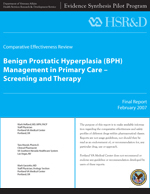
|
Investigators: Mark Helfand, MD, MPH, FACP, Tara Muzyk, PharmD,and Mark Garzotto, MD.
Portland VA Medical Center, Portland, OR
VA Southern Nevada Healthcare System, Las Vegas, NV Washington (DC): Department of Veterans Affairs; February 2007. |
Download PDF: Complete Report, Executive Summary, Report, Appendices
Benign prostatic hyperplasia (BPH) causes urinary hesitancy and intermittency, weak urine stream, nocturia, frequency, urgency, and the sensation of incomplete bladder emptying. These symptoms, collectively called "lower urinary tract symptoms," or LUTS, can significantly reduce quality of life. Depending upon the severity of sypmtoms, men may be managed without pharmacotherapy, or they may require medical treatments of drugs from two main classes. This Evidence Synthesis Report addresses the following questions about treatment for BPH:
Treatment of Benign Prostatic Hyperplasia: A Synthesis of the Evidence (VA HSR&D Management e-Brief) (56 KB, PDF)